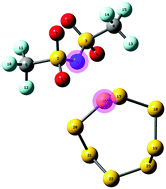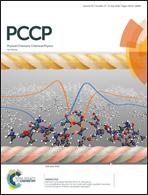First-principles calculations of oxidation potentials of electrolytes in lithium–sulfur batteries and their variations with changes in environment†
Abstract
Oxidation potentials of electrolyte molecules in Li–sulfur (Li/S) batteries and their variations in various solvent environments are investigated using first-principles calculations in order to understand oxidative decomposition reactions of electrolytes for cathode passivation. Electrolyte solvents, Li salts, and various additives in Li/S batteries along with some Li-ion battery additives are studied. Oxidation potentials of isolated electrolyte molecules are found to be out of the operating range of typical Li/S batteries. The complexation of electrolyte molecules with Li+, salt anion, salt, S8, and pyrene alters oxidation potentials compared to those of the isolated systems. The salt anion lowers oxidation potentials of electrolyte molecules by at least 4.7% while the complexes with Li+ have higher oxidation potentials than the isolated molecules by at least 10.4%. S8 and pyrene, used as model compounds for sulfur and sulfur/carbon composite cathode materials, also affect oxidation potentials of electrolyte molecules, but their influence is negligible and the oxidation trends differ from those of the Li+ and salt anion. Although complexations change the oxidation potentials of electrolyte molecules, they are still higher than the operating voltage range of Li/S batteries, which indicates that oxidation of the studied electrolytes in Li/S batteries is not expected under ambient conditions.



 Please wait while we load your content...
Please wait while we load your content...
